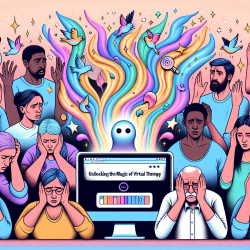The recent study titled Therapists’ Experiences With the Effectiveness and Feasibility of Videoconference-Based Eye Movement Desensitization and Reprocessing sheds light on the promising potential of videoconference-based EMDR (eEMDR). This study, conducted by Mischler et al. (2021), is particularly relevant for therapists seeking to enhance their practice with data-driven insights.
Here are some key takeaways from the research:
- Effectiveness of eEMDR: The study found that eEMDR sessions resulted in a significant decrease in the subjective unit of disturbance (SUD) ratings, comparable to traditional face-to-face EMDR sessions. This suggests that eEMDR can be an effective alternative for trauma therapy.
- Mode of Bilateral Stimulation: Eye movements were found to be more effective in reducing SUD ratings than tapping. This insight can help therapists choose the most effective method for their eEMDR sessions.
- Technical and Bureaucratic Challenges: The study identified unstable internet connections and bureaucratic barriers as the main impediments to eEMDR. Addressing these issues can significantly improve the feasibility of eEMDR.
- Therapist and Patient Experience: The research found that the effectiveness of eEMDR was independent of the therapists' professional experience and the age or sex of both therapists and patients. This suggests that eEMDR can be universally applied across diverse demographics.
Based on these findings, here are some actionable steps for practitioners:
- Optimize Technical Setup: Ensure a stable internet connection and reliable technical equipment to minimize disruptions during sessions.
- Choose Effective Bilateral Stimulation Methods: Prioritize eye movements over tapping for better treatment outcomes.
- Encourage Further Research: Conduct your own small-scale studies or case reports to contribute to the growing body of evidence supporting eEMDR.
In conclusion, eEMDR offers a viable and effective alternative to traditional face-to-face EMDR, especially in the context of the COVID-19 pandemic and beyond. By addressing technical challenges and optimizing treatment methods, therapists can significantly improve the outcomes of their eEMDR sessions.
To read the original research paper, please follow this link: Therapists’ Experiences With the Effectiveness and Feasibility of Videoconference-Based Eye Movement Desensitization and Reprocessing.










